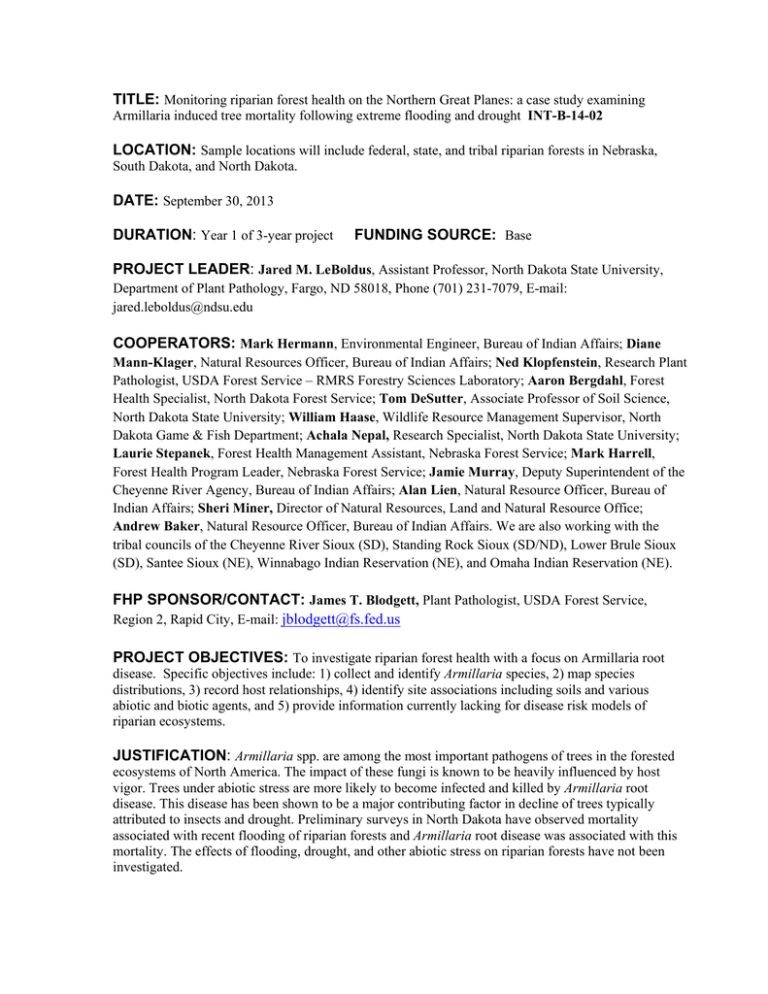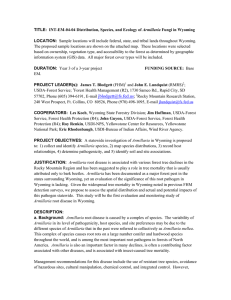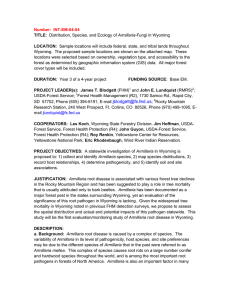TITLE: LOCATION:
advertisement

TITLE: Monitoring riparian forest health on the Northern Great Planes: a case study examining Armillaria induced tree mortality following extreme flooding and drought INT-B-14-02 LOCATION: Sample locations will include federal, state, and tribal riparian forests in Nebraska, South Dakota, and North Dakota. DATE: September 30, 2013 DURATION: Year 1 of 3-year project FUNDING SOURCE: Base PROJECT LEADER: Jared M. LeBoldus, Assistant Professor, North Dakota State University, Department of Plant Pathology, Fargo, ND 58018, Phone (701) 231-7079, E-mail: jared.leboldus@ndsu.edu COOPERATORS: Mark Hermann, Environmental Engineer, Bureau of Indian Affairs; Diane Mann-Klager, Natural Resources Officer, Bureau of Indian Affairs; Ned Klopfenstein, Research Plant Pathologist, USDA Forest Service – RMRS Forestry Sciences Laboratory; Aaron Bergdahl, Forest Health Specialist, North Dakota Forest Service; Tom DeSutter, Associate Professor of Soil Science, North Dakota State University; William Haase, Wildlife Resource Management Supervisor, North Dakota Game & Fish Department; Achala Nepal, Research Specialist, North Dakota State University; Laurie Stepanek, Forest Health Management Assistant, Nebraska Forest Service; Mark Harrell, Forest Health Program Leader, Nebraska Forest Service; Jamie Murray, Deputy Superintendent of the Cheyenne River Agency, Bureau of Indian Affairs; Alan Lien, Natural Resource Officer, Bureau of Indian Affairs; Sheri Miner, Director of Natural Resources, Land and Natural Resource Office; Andrew Baker, Natural Resource Officer, Bureau of Indian Affairs. We are also working with the tribal councils of the Cheyenne River Sioux (SD), Standing Rock Sioux (SD/ND), Lower Brule Sioux (SD), Santee Sioux (NE), Winnabago Indian Reservation (NE), and Omaha Indian Reservation (NE). FHP SPONSOR/CONTACT: James T. Blodgett, Plant Pathologist, USDA Forest Service, Region 2, Rapid City, E-mail: jblodgett@fs.fed.us PROJECT OBJECTIVES: To investigate riparian forest health with a focus on Armillaria root disease. Specific objectives include: 1) collect and identify Armillaria species, 2) map species distributions, 3) record host relationships, 4) identify site associations including soils and various abiotic and biotic agents, and 5) provide information currently lacking for disease risk models of riparian ecosystems. JUSTIFICATION: Armillaria spp. are among the most important pathogens of trees in the forested ecosystems of North America. The impact of these fungi is known to be heavily influenced by host vigor. Trees under abiotic stress are more likely to become infected and killed by Armillaria root disease. This disease has been shown to be a major contributing factor in decline of trees typically attributed to insects and drought. Preliminary surveys in North Dakota have observed mortality associated with recent flooding of riparian forests and Armillaria root disease was associated with this mortality. The effects of flooding, drought, and other abiotic stress on riparian forests have not been investigated. a. Linkage to FHM program. No information is currently available on species distribution of Armillaria fungi in riparian ecosystems of the Great Planes. This survey will provide baseline data on the distribution of Armillaria species in riparian ecosystems which can be used in disease risk models. Furthermore, this information can be used as a baseline to measure changes in tree mortality which may occur due to climate change and extreme weather events (flooding and drought). b. Significance/Impact of forest health issue. Riparian forests are the only ecosystems with trees across most of the Great Plains. They are extremely important for wildlife habitat, water quality, and reducing flooding impacts. The unusual weather events (floods and droughts) experienced by riparian forests in recent years has impacted their health and may trigger development of diseases such as Armillaria that develop on host trees under abiotic stress. The changing climate and deviations from normal weather patterns may impact the distribution, severity, and incidence of Armillaria root rot in these important forest ecosystems. c. Scientific basis. Similar surveys have been conducted in other forest ecosystems by the FHP sponsor and other researchers and subsequently used to develop disease risk models for Armillaria. This survey follows similar procedures and will provide new information regarding species, distribution, and ecology of Armillaria species in riparian forests which will be used in disease risk models. Changing climates and unusual weather events have led to deviations in expected mortality patterns of forest trees in other ecosystems. Armillaria root disease has been associated with mortality during a preliminary survey of riparian ecosystems in North Dakota. d. Cost/Economic efficiency. This study will build on methods already developed and take advantage of other funding sources listed in "COSTS" below. This study also utilizes the expertise in multiple agencies including the USDA Forest Service, Bureau of Indian Affairs, tribal members, and State agencies. e. Priority Issues. This study will examine various abiotic and biotic agents (including root disease) associated with tree mortality in riparian forests. This addresses the priority issues of climate change on riparian forests, impacts of unusual weather events, and filling gaps in disease risk models. Furthermore, this survey will provide baseline data from which deviations from expected tree mortality attributed to Armillaria can be identified. DESCRIPTION: a. Background: Armillaria fungi cause root rots on a large number of conifer and hardwood species around the world, and are one of the most important pathogens in North American forests. Armillaria root disease is caused by a complex of species previously referred to as Armillaria mellea. Currently there are nine described species of Armillaria in North America and one undescribed unnamed biological species (Ross-Davis et al. 2012). The variability of Armillaria in its level of pathogenicity, host species, and site preferences may be due to the different species. Studies in other regions have indicated that not only does Armillaria have specific host and site associations (Mallet and Maynard 1998) but the impact of Armillaria varies with condition (Mallet 1990). For example, Armillaria has been demonstrated to have a greater impact on stressed trees compared to vigorously growing trees (Entry et al. 1992). Armillaria is also an important factor in many declines, is often a contributing factor associated with other diseases, and is associated with insect-caused tree mortality. Armillaria root disease is expected to be a major component in the recent mortality observed in riparian forests. As climatic regimes change, increasing abiotic stress experienced by our forest resources, increased impacts can be expected from these pathogens. b. Methods: Federal, state, and tribal riparian forests in Nebraska, South Dakota, and North Dakota will be surveyed for the presence of Armillaria spp. Plot locations will be systematically selected based on ownership, riparian vegetation type, and accessibility determined by geographic information system (GIS) data. A three by three mile grid will be overlain on a map of Missouri river and its major tributaries in the three states. All grid points not falling on forest land or falling on inaccessible forest land will be eliminated. Final site selection will be stratified based on forest cover type to ensure that all cover types are equally sampled. Sites will be surveyed using methods modified from Blodgett and Worrall (1992a and 1992b). At each location plots will be established and the following information will be recorded: altitude; slope; aspect; forest cover type; organic matter thickness; tree species and DBH for live, recent dead, and old dead trees. All significant damage agents will be noted. Soil samples will be collected and analyzed for organic matter content, pH, and texture. For trees within plots the following information will be recorded: host condition (live/dead); presence of Armillaria symptoms and signs (resinosis, mycelial fans, and/or rhizomorphs); DBH; species; crown position; percentage live crown; and associated abiotic and biotic stress/mortality agents. Samples of decayed wood; mycelial fans; and/or rhizomorphs will be collected from infected trees at each location. These samples will be used for species identification (Blodgett and Worrall 1992a; Ross-Davis et al. 2012). c. Products: Along with providing new information about an important forest health issue, this study will: 1) examine the relationships among the different species of Armillaria and their associated stand ecology, 2) result in the diagnosis of pathogenic Armillaria species in riparian ecosystems of the northern Great Plains, and 3) provide the base information for future monitoring/surveys. In doing this we will develop coarse-scale distribution and hazard maps for this pathogen and other important diseases/insects found during the survey. The spatial distribution of Armillaria will be compared with FHM Detection Monitoring data and annual precipitation data. This study will result in at least two full-length publications, and potentially a third paper using predictive spatial modeling developed by the Rocky Mountain Research Station (RMRS). Publications will be distributed to all federal, state, and tribal lands involved, land managers and others in areas of forest stewardship, as well as others interested parties. Results will be presented at the Forest Health Monitoring Working Group Annual Meeting, the American Phytopathological Society Annual Meeting, the Western International Forest Disease Work Conference, the Great Plains Tree Pest Council, and other regional meetings as appropriate. This study will also promote interagency collaboration and develop strong relationships with tribal partners. d. Schedule of Activities: Summer 2014 - Complete 100 field plots before the end of 2014 (SD). Winter 2014/15 - Identify isolates collected, start soil analyses, and present progress report at FHM meeting. Summer 2015 - Complete 100 additional (200 total) field plots before the end of 2015 (ND). Winter 2015/16 - Identify isolates collected in 2005, soil analyses, and present preliminary results. Summer 2016 - Complete 50 additional (250 total) field plots before the end of 2016 (NE). Winter 20016/17 - Identify isolates collected in 2016, complete soil analyses, write the final papers, and give presentations at national and regional meetings. Progress/Accomplishments: N/A e. Relevant Citations: Blodgett JT and Worrall JJ. 1992a. Distributions and hosts of Armillaria species in New York. Plant Disease 76:166-170. Blodgett JT and Worrall JJ. 1992b. Site relationships of Armillaria species in New York. Plant Disease 76:170-174. Ross-Davis AL, Hanna JW, Kim M-S, and Klopfenstein NB. 2012. Advances toward DNAbased identification and phylogeny of North American Armillaria species using elongation factor-1 alpha gene. Mycoscience 53: 161-165. Mallett KI. 1990. Host range and geographic distribution of Armillaria root rot pathogens in the Canadian Prairie Provinces. Can. J. For. Res. 20: 1859-1863. Mallett KI and Maynard DG. 1998. Armillaria root disease, stand characteristics, and soil properties in young lodgepole pine stands. Forest Ecology and Management. 105: 37-44. Michaelian M, Hogg EH, Hall RJ, Arsenault E. 2011. Massiva mortality of aspen following severe drought along the southern edge of the Canadian boreal forest. Global Change Biology 17:2084-2094. Van Mantgem PJ, Stephenson NL, Byrne JC, Daniels LD, Franklin JF, Fule PZ, Harmon ME, Larson AJ, Smith JM, Taylor AH, and Veblen TT. 2009.Widespread increase of tree mortality rates in the western United States. Science 323:521-524. Worrall JJ, Egeland L, Eager T, Mask RA, Johnson EW, Kemp PA, Shepperd WD. 2008. Rapid mortality of Populus tremuloides in southwestern Colorado, USA. Forest Ecology and Management 255: 686-696. Worrall JJ, Marchetti SB, Egeland L, Mask RA, Eager T, Howell B. 2010. Effects and etiology of sudden aspen decline in southwestern Colorado, USA. Forest Ecology and Management 260:638-648. COSTS: Item Requested FHM EM Funding Other-Source Funding Source YEAR 1 (2014)* Administration Salary Overhead Travel Procurements Contracting Equipment Supplies $19,055+ $7,000+$4,680 FHM, NDSU $600+$3000 FHM, NDSU $2,706 $5,500+ $700 $2,500 *Total $29,761 $15,980 + For graduate student, field work, and presentations at meetings. * A similar budget is expected in year 2 and 3. FHM




